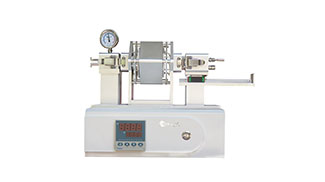The element in the tube furnace is the heating chamber. It is composed of a circular furnace wall made of high-temperature ceramics; it is formed by a complete cylindrical element or two semi-cylindrical elements close to forming a single cavity. Refractory heating coils or ribbons are embedded in ceramics, and the central chamber is surrounded by evenly distributed heaters. This structure guarantees the highest thermal uniformity when processing both inorganic and organic compounds.
Split tube furnace: The split tube furnace is the main equipment for academic facilities and R&D applications. It consists of a half-open hinged body for easy access to the internal furnace chamber.
Solid tube furnace: The solid tube furnace is neither vertically nor longitudinally opened. They use a process tube that passes through a fixed heating cylinder; a configuration that is ideal for application, batch development of repetitive sample sizes.
Numerous heat treatment formats are available for researchers and manufacturers to process relatively small sample volumes or low-throughput operations. At these scales, benchtop laboratory ovens are often superior-yet the geometry of the heat treatment chamber may be a limiting factor in certain applications.
At the beginning of the 20th century, the development of fine ceramic filaments led to the birth of the first cylindrical heating chamber, and tube heating furnaces have since become common equipment in factory workshops and material laboratories all over the world.
The lab tube furnace consists of a heating furnace body and a waste heat recovery system. The body of the tube heating furnace provides a chimney baffle, and the body of the heating furnace provides a high-temperature flue gas outlet in the baffle below the chimney, and the waste heat recovery system includes an air preheater, which is characterized by two stages in the air preheater, that is, non-condensing air preheater, and a condensing air preheater. Tube furnaces are mainly used for experiments and small batch production in universities, research institutes, industrial and mining enterprises, etc. It has the characteristics of safety and reliability, simple operation, high-temperature control accuracy, good heat preservation effect, large temperature range, high furnace temperature uniformity, multiple temperature zones, optional atmosphere, vacuum furnace type, etc.
The main reason for using tube heating furnaces is the unparalleled thermal uniformity of cylindrical heating furnaces. The components in the single-zone cavity are subjected to a continuous heating value of more than 1000°C (1832°F) over the entire 360° axis, which ensures the best distribution of heat across the full cross-section of the component. This makes the tube furnace very suitable for sensitive heat treatment applications such as thermocouple calibration.
The electric muffle furnace can also integrate multiple heating zones to improve the processing capacity of the instrument. This allows a fully controllable temperature gradient to fine-tune the heating and cooling phases of the heat treatment. It can also limit the peak temperature to a specific area of interest on a component-usually the middle part so that either end can be safely processed with additional mechanical equipment. This is very useful in a series of material testing applications and can accurately characterize the mechanical properties of materials at high temperatures.

评论
发表评论